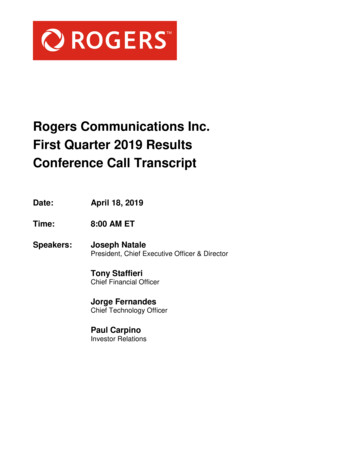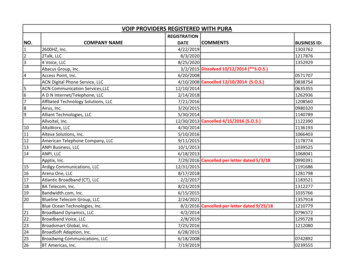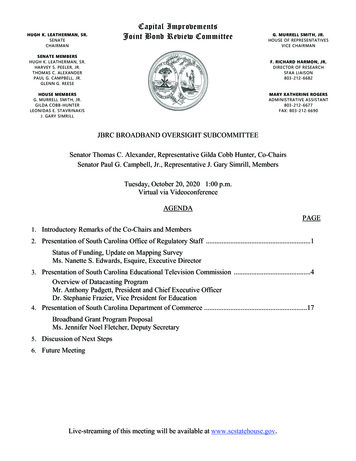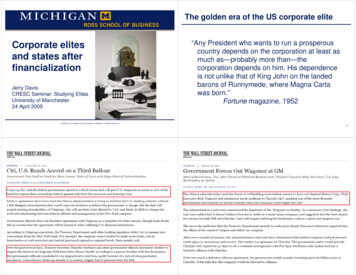
Transcription
e-documentFILEDT-955-21-ID 123DÉFEDERAL COURTPCOUR FÉDÉRALEOSÉNovember 17, 2021Court File No. T-955-21B E T W E E N:FEDERAL COURT17 novembre 2021Jonathan MacenaROGERS MEDIA INC, ROGERS COMMUNICATIONS INC, BCE INC,OTTBELLMEDIA INC, CTV SPECIALTY TELEVISION ENTERPRISE INC, THESPORTS NETWORK INC, LE RESEAU DES SPORTS (RDS) INC, ANDGROUPE TVA INCPLAINTIFFS- and JOHN DOE 1, JOHN DOE 2, AND OTHER UNIDENTIFIED PERSONS WHOOPERATE UNAUTHORIZED STREAMING SERVERS PROVIDINGACCESS TO NHL LIVE GAMES IN CANADADEFENDANTS- and -BELL CANADA, BRAGG COMMUNICATIONS DBA EASTLINK, COGECOCONNEXION INC, DISTRIBUTEL COMMUNICATIONS LIMITED, FIDOSOLUTIONS INC, ROGERS COMMUNICATIONS CANADA INC,SASKATCHEWAN TELECOMMUNICATIONS INC, SHAWCOMMUNICATIONS INC, TEKSAVVY SOLUTIONS INC, TELUSCOMMUNICATIONS INC, AND VIDEOTRON LTD- and -THIRD PARTY RESPONDENTSSAMUELSON-GLUSHKO CANADIAN INTERNET POLICY & PUBLICINTEREST CLINIC (CIPPIC) AND BEANFIELD TECHNOLOGIES INCINTERVENERSMEMORANDUM OF FACT AND LAW OF THE INTERVENER,SAMUELSON-GLUSHKO CANADIAN INTERNET POLICY AND PUBLICINTEREST CLINICPUBLIC VERSIONSamuelson-Glushko Canadian Internet Policy & Public Interest Clinic (CIPPIC)University of Ottawa, Faculty of Law, Common Law Section57 Louis Pasteur StreetOttawa, ON K1N 6N5Tamir IsraelTel: 1 613-562-5800 x 2914Fax: 1 613-562-5417Email: tisrael@cippic.caCounsel for the Intervener66
TO: THE ADMINISTRATORFEDERAL COURTAND TO: SMART & BIGGAR LLP1000 de la gauchetière Street West, Suite 3300Montreal, QC H3B 2W5François Guay (fguay@smartbiggar.ca)Jean-Sébastien Dupont (jsdupont@smartbiggar.ca)Guillaume Lavoie Ste-Marie (glavoiestemarie@smartbiggar.ca)Olivier Jean-Lévesque (ojean-levesque@smartbiggar.ca)Tel: 1 514-954-1500Fax: 1 514-954-1396Counsel for the Plaintiffs and for the Third Party Respondents, BellCanada, Fido Solutions Inc, Rogers Communications Inc, Videotron LtdAND TO: STEWART MCKELVEYQueen’s Marque, #600-1741Lower Water Street, PO Box 997Halifax, NS B3J 2X2Nancy G Rubin, QC (nrubin@stewartmckelvey.com)Tel: 1 902-420-3337Fax: 1 902-488-8727EASTLINK801-6080 Young StreetHalifax, NS B3K 5M3Natalie MacDonald (legal.matters@corp.eastlink.ca)Tel: 1 902-431-9979Fax: 1 902-446-9979Counsel for the Third Party Respondent, Bragg Communications Incdba EastlinkAND TO: ROBIC, LLP630 Boul René-Lévesque West20th FloorMontreal, QC H3B 1S6Bob H Sotiriadis (sotiriadis@robic.com)Cara Parisien (parisien@robic.com)Zachary Ouimet (ouimet@robic.com)Tel: 1 514-987-8899Fax: 1 514-845-7874Counsel for the Third Party Respondent, Cogeco Connexion Inc
AND TO: AIRD & BERLIS LLPBrookfield Place, 181 Bay StreetSuite 1800, Box 754Toronto, ON M5J 2T9Timothy Lowman (tlowman@airdberlis.com)Tel: 1 416-863-1500Fax: 1 416-863-1515Counsel for the Third Party Respondent, Distributel CommunicationsLimitedAND TO: SASKATCHEWAN TELECOMMUNICATIONS HOLDING CORP2121 Saskatchewan DriveRegina, SK S4P 3Y2Kevin Spelay (Kevin.spelay@sasktel.com)Tel: 1 306-777-3706Third Party Respondent, Saskatchewan Telecommunications HoldingCorporationAND TO: SHAW COMMUNICATIONS INC#40-1400 Elgin StreetOttawa, ON K1P 5K6Cynthia Rathwell (cynthia.rathwell@sjrb.ca)Cynthia Wallace (cynhia.wallace@sjrb.ca)Tel: 1 403-750-4500Fax: 1 403-780-7469Third Party Respondent, Shaw Communications IncAND TO: TEKSAVVY SOLUTIONS INC800 Richmond StreetChatham, ON N7M 5J5Andy Kaplan-Myrth (akaplanmyth@teksavvy.com)Jessica Rutledge (jrutledge@teksavvy.com)Tel: 1 613-222-9626Fax: 1 519-360-1716Counsel for the Third Party Respondent, TekSavvy Solutions IncAND TO: OSLER, HOSKIN & HARCOURT LLP1 First Canadian Place, 100 King Street WestSuite 6200, Box 50Chris Naudie (cnaudie@osler.com)Sydney Young (seyoung@osler.com)
Tel: 1 416-862-6811Fax: 1 416-862-6666Counsel for the Third Party Respondent, TELUS Communications IncAND TO: 32M LAW PCBox 563, Station PToronto, ON M5S 2T1Bram Abramson (bram@32M.io)Tel: 1 416-613-5056Counsel for the Intervener, Beanfield Technologies Inc
iTABLE OF CONTENTSPART I - STATEMENT OF FACTS1PART II - ISSUES2PART III - SUBMISSIONS2A. Legal Test for Webiste Blocking2B. RJR in Context: the Copyright Act, the Telecom Act, and the FreeExpression3C. Applying RJR to Dynamic Website Blocking5(a) Establishing a Strong Prima Facie Casei. Ensure legitimate services are not captured.57ii. A sufficiently precise evidentiary basis against all Defendants is necessary. 8iii. Novel & contested forensic techniques require proper validation.10(b) Non-speculative and Irreparable Harm12(c) Balance of Convenience:14i. Imposing Notice-Takedown15ii. Net Neutrality is directly implicated17iii. Minimal judicial supervision undermines free expression & public policy 18iv. Impact on affordability and competition19D. Ensuring Transparency20PART IV - ORDER SOUGHT20PART V - AUTHORITIES22
1B E T W E E N:Court File No. T-955-21FEDERAL COURTROGERS MEDIA INC, ROGERS COMMUNICATIONS INC, BCE INC, BELLMEDIA INC, CTV SPECIALTY TELEVISION ENTERPRISE INC, THESPORTS NETWORK INC, LE RESEAU DES SPORTS (RDS) INC, ANDGROUPE TVA INCPLAINTIFFS- and JOHN DOE 1, JOHN DOE 2, AND OTHER UNIDENTIFIED PERSONS WHOOPERATE UNAUTHORIZED STREAMING SERVERS PROVIDINGACCESS TO NHL LIVE GAMES IN CANADADEFENDANTS- and -BELL CANADA, BRAGG COMMUNICATIONS DBA EASTLINK, COGECOCONNEXION INC, DISTRIBUTEL COMMUNICATIONS LIMITED, FIDOSOLUTIONS INC, ROGERS COMMUNICATIONS CANADA INC,SASKATCHEWAN TELECOMMUNICATIONS INC, SHAWCOMMUNICATIONS INC, TEKSAVVY SOLUTIONS INC, TELUSCOMMUNICATIONS INC, AND VIDEOTRON LTDTHIRD PARTY RESPONDENTS- and -SAMUELSON-GLUSHKO CANADIAN INTERNET POLICY & PUBLICINTEREST CLINIC (CIPPIC) AND BEANFIELD TECHNOLOGIES INCINTERVENERSMEMORANDOM OF FACT AND LAWPUBLIC VERSION1.The remedy sought by the Plaintiffs would create a novel website blockingcapability in Canadian Internet networks, operated primarily by a private companywith minimal court supervision. Its issuance must fully account for the detrimentalimpactonpolicy nications Act, as well as on the freedom of expression.PART I - STATEMENT OF FACTS2.CIPPIC takes no position on the facts.1
2PART II - ISSUES3.This motion raises one issue: whether the Plaintiffs’ dynamic website blockinginjunction should be issued.PART III - SUBMISSIONS4.CIPPIC takes no position on the outcome of this matter. Our submissions focuson the importance of ensuring that all detrimental impacts on the public interest thatwill result from the issuance of this order are taken into account as the Courtconsiders whether to issue this novel dynamic website blocking remedy.A. LEGAL TEST FOR WEBISTE BLOCKING5.The availability of website blocking orders and the legal test governing theirissuance was affirmed by the Federal Court of Appeal in Teksavvy Solutions v BellMedia,1 and is not at issue in this proceeding.6.Both the constituent elements of this legal test and the availability of ISP-basedwebsite blocking more broadly as a remedy for copyright infringement have beenappealed to the Supreme Court of Canada.27.For the purposes of this proceeding, CIPPIC accepts the legal test for ISP-blocking injunctions as approved by the Federal Court of Appeal in Teksavvy, as wellas the underlying questions of jurisdiction that were addressed in that Appeal.8.Interlocutory injunctions are an extraordinary and exceptional remedy. Applicantsmust establish a strong prima facie case in the underlying merits of their cause, that theinjunction is necessary to prevent irreparable harm, and that the balance of conveniencefavours issuance of the relief.31Teksavvy Solutions v Bell Media, 2021 FCA 100, Plaintiffs’ Book of Authorities(PBA), Tab 24.2Teksavvy Solutions v Bell Media, SCC File No 39876.3RJR-MacDonald v Canada, [1994] 1 SCR 311, PBA Tab 22; Google v Equustek2
39.The test is holistic. A strong showing on one prong of the test can weigh infavour of allowing an injunction even where one or both of the other prongs are lessfirmly established.4 However, a strong showing on one prong cannot obviate the needto meet a baseline threshold on the other two prongs. 5 The over-riding considerationis to ensure that the injunctive relief is just and equitable, taking into account theparticular circumstances of the case.610.Several contextual factors require a more rigorous application of these factorsin the context of the dynamic website blocking injunction sought in this proceeding:the relief sought is mandatory rather than prohibitive in nature, the remedy is againstinnocent third parties and its implementation requires substantial changes to theservices of these third parties; the relief is sought on largely an ex parte basis; and therelief is effectively final in nature. Each of these contextual factors have implicationsfor assessing the test for injunctive relief, and are referred to at various points below.11.Additional factors developed by the British courts may also inform the applicationof the general test for interlocutory injunctive relief to the specific context of websiteblocking injunctions, but are not an integral part of it.712.Finally, as elaborated below, courts may look to any directly implicated statutory orconstitutional contexts for additional guidance when assessing the test for injunctive relief.B. RJR IN CONTEXT: THE COPYRIGHT ACT, THE TELECOM ACT, ANDTHE FREE EXPRESSIONSolutions Inc, [2017] 1 SCR 824, PBA Tab 17; R v Canadian Broadcasting Corp,[2018] 1 SCR 196, PBA Tab 20.4Plaintiffs, Written Representations, July 7, 2021, Motion Record, Vol 3, Tab 13[PWR] para 170.5Janssen v Abbvie Corporation, 2014 FCA 112, paras 19-26; Robinson v Canada(Attorney General), 2019 FC 876, para 57.6Google v Equustek Solutions Inc, [2017] 1 SCR 824, PBA Tab 17, para 25; Letnes vCanada (Attorney General), 2020 FC 636, para 36.7Teksavvy Solutions v Bell Media, 2021 FCA 100, PBA Tab 24, paras 74 and 76-77.3
413.This Court’s application of the test for ISP-based website blocking should takeinto account the Copyright Act, the Telecommunications Act, and the right to freeexpression, each of which is directly implicated by several elements of the reliefsought by the Plaintiffs.14.In Teksavvy v Bell, the Federal Court of Appeal held that neither theTelecommunications Act, nor the Copyright Act explicitly preclude the issuance ofwebsite blocking injunctions against Canadian telecommunications carriers.815.CIPPIC submits that the Copyright Act and the Telecommunications Act continueto provide critical context for the injunctive relief sought in this proceeding is just andequitable.9 The Court’s application of the RJR-MacDonald framework must also beapplied in a manner that respects freedom of expression. We submit that the test forinjunctive relief provides a “general framework”10 that takes its “colour from thecontext”, much as administrative law takes its colour from statutory or constitutionalcontexts implicated by the exercise of administrative powers.1116.The plaintiffs in this matter seek the court’s assistance to enforce theircopyright. Sub-section 34(1) preserves this court’s remedial powers of injunctiverelief, in a manner that remains “subject to [that] Act”.12 The Copyright Act istherefore necessarily engaged, and the court’s remedial powers must be informed byits statutory text, context and purpose.13 Notably, enforcement remedies are to beapplied in a manner that respects the balance between users’ rights and copyrightholder’s interests which is the Copyright Act’s animating purpose.148Teksavvy Solutions v Bell Media, 2021 FCA 100, PBA Tab 24, paras 29-32 and 36.Teksavvy Solutions v Bell Media, 2021 FCA 100, PBA Tab 24, para 44.10R v Canadian Broadcasting Corp, [2018] 1 SCR 196, PBA Tab 20, para 13.11Canada (Minister of Citizenship and Immigration) v Vavilov, 2019 SCC 65, para89 Warman v Fournier, 2012 FC 803, paras 18-21.12Copyright Act, RSC 1985, c C-42, PBA Tab 32, s 34(1).13Warman v Fournier, 2012 FC 803, para 20.14Théberge v Galerie d’Art du Petit Champlain Inc, [2002] 2 SCR 336, 2002 SCC 34,per Binnie, J., paras 31 and 76-79 and per Gonthier, J, dissenting, but not on this,94
517.Similarly, the remedy sought by the plaintiffs would compel varioustelecommunications carriers to block access to specific content. Canadian carriers such asthe third party respondent Internet Service Providers (ISPs) are regulated by theTelecommunications Act,15 and, indeed, in the absence of the court order sought by theplaintiffs, voluntary blocking of this nature would violate that Act.16 TheTelecommunications Act therefore also provides important context for the application ofthe general RJR-McDonald framework to the particular circumstances of an ISP-baseddynamic blocking injunction. Particularly relevant to this proceeding is the principle ofnet neutrality and the importance of ensuring affordable and competitive ISP services inCanada—considerations that are central to the Telecommunications Act.18.Finally, we note that website blocking more broadly engages freedom ofexpression and that dynamic website blocking in particular poses a risk of overblocking. The general test for injunctive relief should therefore take into account anypotential impact on free expression.17C. APPLYING RJR TO DYNAMIC WEBSITE BLOCKING19.The dynamic website blocking relief sought here is unique and novel inCanadian law. Several contextual factors must be considered in the ultimateassessment of its issuance.(a) Establishing a Strong Prima Facie Case20.Interlocutory injunctive relief requires an applicant to establish the merits oftheir underlying claim. Generally, applicants need only demonstrate that there is aparas 129-134.15Telecommunications Act, SC 1993, c 38, PBA Tab 35, ss 2(1), 7, 23, 27(1) and 36;PWR, para 237.16Telecom Regulatory Policy CRTC 2009-657, October 21, 2009, paras 121-122;Teksavvy Solutions v Bell Media, 2021 FCA 100, PBA Tab 24, para 36.17Vancouver Aquarium Marine Science Centre v Charbonneau, 2017 BCCA 395,paras 41-42, 72, 75-76 and 78; Canada (Human Rights Commission) v CanadianLiberty Net, [1998] 1 SCR 626.5
6“serious question to be tried”—a relatively low threshold. As the relief sought in thisproceeding is mandatory and effectively final in nature, the merits of the Plaintiffs’ultimate claim must be established to a higher threshold.21.Mandatory injunctions are more intrusive than prohibitive injunctions as theyrequire targets to take active steps rather than merely prohibiting targets frominfringing the plaintiff’s rights. In recognition of this higher level of intrusiveness, thefirst prong of the test for mandatory injunctive relief requires plaintiffs to establish astrong prima facie case on the ultimate merits rather than merely demonstrating thatthere is a serious issue to be tried.1822.Even where prohibitive injunctions are at issue, the remedy sought by thePlaintiffs here is effectively final in nature and would demand higher scrutiny of theultimate merits of their claim. The Plaintiffs’ materials make it clear that there is nointention to pursue—or even identify—the defendants in the underlying matter.19Instead the interlocutory relief sought would establish an ongoing framework forblocking access to streaming services offered by an open-ended category ofdefendants. Seeking relief that is effectively final in nature does not renderinterlocutory relief unavailable.20 But applicants seeking a remedy that is, for allintents and purposes, final in nature must establish the merits of their underlying caseto a higher standard.2118R v Canadian Broadcasting Corp, [2018] 1 SCR 196, PBA Tab 20, paras 12-16;Teksavvy Solutions v Bell Media, 2021 FCA 100, PBA Tab 24, para 64.19PWR, para 227;20Teksavvy Solutions v Bell Media, 2021 FCA 100, PBA Tab 24, para 43.RJR-MacDonald v Canada, [1994] 1 SCR 311, PBA Tab 22, p 338:Whether the test has been satisfied should be determined by a motions judge onthe basis of common sense and an extremely limited review of the case on themerits. . A motions court should only go beyond a preliminary investigation intothe merits when the result of the interlocutory motion will in effect amount to afinal determination of the action, or when the constitutionality of a challengedstatute can be determined as a pure question of law.See discussion in Okojie v Canada (Citizenship and Immigration), 2019 FC 880,216
723.The Plaintiffs therefore bear the burden of establishing a strong prima faciecase by demonstrating a strong likelihood of success on the legal and factual merits oftheir underlying application.2224.To meet this burden, the Plaintiffs do not directly establish a strong prima faciecase against each of the Defendants whose activities will ultimately be captured by thewebsite blocking mechanism they seek to put in place. Instead, the Plaintiffs specify aprocess for identifying infringing activity originating from a general category ofDefendants.23 A sufficiently strong prima facie case must nonetheless be establishedagainst each of the Defendants on the record of this proceeding.i. Ensure legitimate services are not captured.25.Under the proposed mechanism, the Plaintiffs have wide latitude to determinewhat constitutes unauthorized copyright infringement as long as the specific stepsoutlined in their respective process are followed. To ensure a strong prima facie caseagainst all Defendants, explicit measures must be in place to clarify that legitimateservices such as Virtual Private Networks (VPNs) are categorically excluded from thescope of the order.26.Virtual Private Networks are a security tool that has been recognized by theCanadian Radio-television and Telecommunications Commission (CRTC) as a“legitimate tool to protect sensitive information”.24 Interfering with the use of VPNscan undermine the policy objectives set out in the Telecommunications Act.2527.VPN services are at times targeted by copyright enforcement measures as useparas 82-86.22R v Canadian Broadcasting Corp, [2018] 1 SCR 196, PBA Tab 20, para 17.23PWR, para 156.24Telecom Regulatory Policy CRTC 2017-104, April 20, 2017, para 78. See also:David Kaye, Report of the United Nations Special Rapporteur on the Promotion andProtection of the Right to Freedom of Opinion and Expression, AEV, May 22, 2015,A/HRC/29/32, para 9.25Telecom Regulatory Policy CRTC 2017-104, April 20, 2017, para 78.7
8of VPN traffic may not be directly caught by website blocking efforts,26 and canfacilitate access to content that is authorized for streaming in other jurisdictions butnot in Canada.27 The CRTC has also ruled that Canadian ISPs cannot capture VPNtraffic in order to ensure a complex content filtering mechanism similar to thatcontemplated here would comprehensively capture targeted content.2828.Explicitly, no strong prima facie case has been established against VPN trafficincluding VPN traffic that seeks to access NHL games that are legitimately licensedfor streaming in jurisdictions outside of Canada.ii. A sufficiently precise evidentiary basis against all Defendants is necessary.29.The majority of Defendants in this proceeding will be identified—and madesubject to this Court’s remedy—through the operation of the Plaintiffs’ proposeddynamic website blocking mechanism. A strong prima facie case must be establishedagainst each of the Defendants who will ultimately be captured by this process. TheOrder underpinning this mechanism employs sufficiently robust standards of proofonto the individuals who will be implementing it. Evidence gathered through theoperation of the website blocking mechanism must also be attested to and regularlysubmitted to the Court so that it forms part of the record of this proceeding.30.26Teksavvy Solutions v Bell Media, 2021 FCA 100, PBA Tab 24, para 20.Bell Canada v Canada (Attorney General), 2019 SCC 66, paras 7-24; David Kaye,Mandate of the United Nations Special Rapporteur on the Promotion and Protection ofthe Right to Freedom of Opinion and Expression, Re: Application to Disable On-lineAccess to Piracy Sites, CRTC File No 8663-A182-201800467, March 29, 2018, para 18.28Canadian Radio-television and Telecommunications Commission, Enforcement andCompliance Branch, Commission Letters to Rogers Communications Inc, Re Section 36of the Telecommunications Act, and Paragraphs 126 and 127 of Telecom RegulatoryPolicy CRTC 2009-657, CRTC File #545613, dated January 20, 2012; February 29,2012; and June 28, 2012.27298
931.32.3031323334359
1033.In order to establish a strong prima facie case against all the entities that willbecome Defendants in this proceeding over time, the evidentiary basis for thePlaintiffs’ various determinations must also be placed on the record on a periodic basis.iii. Novel & contested forensic techniques require proper validation.34.A strong prima facie case requires a sufficient evidentiary basis to establish ahigh likelihood of success in the underlying proceeding against each of theDefendants. Evidence generated by novel or contested forensic techniques must beproperly validated to provide such an evidentiary basis. This is particularly so wherethe matter is proceeding on an effectively ex parte basis, where the remedy sought iseffectively final in nature, and where the forensic techniques in question are playing adeterminative role in determining fault.35.The rules of evidence impose a gate-keeping function on courts where expertevidence that is based on novel or contested forensic science is relied upon.38 Whereforensic scientific tools are contested or novel, peer review and external validation ofthe reliability of these tools is an important consideration in validating.39 The trier offact must be able to exercise “informed judgement” and should not premise factualdeterminations on an “act of faith” in the expert’s opinion or the forensic technique.40363738White Burgess Langille Inman v Abott and Haliburton Co, [2015] 2 SCR 182,paras 18 and 23.39White Burgess Langille Inman v Abott and Haliburton Co, [2015] 2 SCR 182, para 18.40White Burgess Langille Inman v Abott and Haliburton Co, [2015] 2 SCR 182, para18; R v J-LJ, [2000] 2 SCR 600, paras 25 and 56; R v Trochym, [2017] 1 SCR 239;See also: New Jersey v Pickett, 246 A.3d 279 (Superior Court of New Jersey,10
1136.37.Content identification forensic tools in general and in the copyrightinfringement context specifically, remain deeply contested.46 New forensic tools andparticularly those operated by private companies require independent verification andpeer-review.47 As currently formulated, this proceeding may represent the lastopportunity that the Court will have to ensure the validity of the forensic mechanismin question. The Plaintiffs will provide the Court with a Report regarding theAppellate Division, 2021), paras 278-79.414243444546Jennifer M Urban, Brianna Schofield & Joe Karaganis, “Takedown in Two Worlds:An Empirical Analysis” (2018) 64 J Copyright Soc’y 483.47Jill R Presser & Kate Robertson, “AI Case Study: Probabilistic Genotyping DNATools in Canadian Criminal Courts”, June 2021, Law Commission of Ontario.11
12implementation of its remedy,48 but it is unclear on what basis the Court may takeadditional steps on its own initiative once this Report is received.38.It is equally unclear whether customers or online services who are detrimentallyimpacted by the dynamic site blocking regime in question will ever realize the sourceof their connectivity problems. Under the proposal, only third party hosts are notifiedand there is no obligation to forward notices to impacted services or to serve thisservices personally.49 The proposal also does not include any measures to redirectimpacted customers to a copyright blocking notice so that they are aware of thesource of their connectivity challenges.5039.The Court’s gate-keeping role with respect to novel and contested scientificforensic techniques is particularly important where evidence is being presented in anex parte context.51 In this respect, we note that no parties with evidentiary standingare directly contesting the merits of the Plaintiffs’ proposed mechanism.(b) Non-speculative and Irreparable Harm40.The second prong of the test for mandatory injunctive relief requires a showingof irreparable harm resulting from infringement of a legally protected interest.Specifically, an applicant must establish a sound evidentiary basis that harm willresult if the injunction is not granted, and that the harm in question will not becompensable through damages. The harm in question must be detailed, concrete, andreal—it cannot be hypothetical or speculative.41.The plaintiffs argue that a clear and unequivocal case of copyright infringementmay justify the issuance of a mandatory injunction on a less robust or even4849PWR, para 229.PWR, para 92;5051ME2 Productions Inc v Doe, 2019 FC 214, para 69.12
13perfunctory showing of irreparable harm.52 This distorts the framework for injunctiverelief, which has always been conjunctive in nature. Each prong of the test addssomething essential to the analysis, and none can be emptied of substance or reduced“down to a box-ticking exercise”.5342.The rationale for rendering the threshold upon a particularly strong showing onthe merits presumes the availability of injunctive relief as a final remedy in allinstances. However, relief continues to issue on something short of a finaldetermination on the merits.54 Moreover, injunctive relief is equitable in nature, andnot all relief is an inevitable result even on a final determination of the merits.55Mandatory injunctions remain an extraordinary remedy and mandatory injunctionsagainst innocent third parties particularly so.43.Importantly, applicants seeking permanent injunctive relief must generallydemonstrate that the relief sought is necessary to address non-compensable harm onfinal basis.56 Depending on the nature of the relief sought, this requirement may bemore or less rigorous.52PWR, para 170, citing Bell Canada v 1326030 Ontario Inc (iTVBox.net), 2016 FC612, PBA Tab 3, para 36.53Janssen Inc v Abbvie Corporation, 2014 FCA 112, paras 19-26; Letnes v Canada(Attorney General), 2020 FC 636, paras 35-36; TELUS Communications Inc vVideotron Ltee, 2021 FC 1127, para 28: (“It is mainly at the third stage of the test thatthe relative weight of competing factors can be balanced”); Robinson v Canada(Attorney General), 2019 FC 876, para 57 (“this does not mean that one of the threecompartments can be completely empty and compensated by the other two beingfilled to a higher level. There still needs to be something in each of the threecompartments and none of the elements of the test can be entirely left aside andrescued by the other two).541711811 Ontario (AdLine) v Buckley Insurance Brokers, 2014 ONCA 125, paras74-80.55Cadbury Schweppes Inc v FBI Foods Ltd, [1999] 1 SCR 142; Labourers’International Union of North America, Local 183 v Castellano, 2020 ONCA 71,paras 23-26.56Google v Equustek Solutions Inc, [2017] 1 SCR 824, PBA Tab 17, per Côté andRowe JJ, dissenting, para 66; Gauthier v Blueberry River First Nations, 2021 FC 446,para 31.13
1444.Assuming that the baseline threshold for irreparable harm can be establishedthrough a robust showing on the merits and a proven likelihood of continuedinfringement,57 it would remain important to demonstrate the overall magnitude ofnon-compensable harm in a concrete and non-speculative manner.45.The demonstrated magnitude of such harm can impact other factors of the testfor injunctive relief and in particular the balance of convenience factor where theapplicant’s interests are weighed against other considerations such as the publicinterest. 5846.This scrutiny is particularly important in an ex parte application where themerits of an applicant’s claims are not fully tested. In the copyright context, courtshave recognized that there are competing methods for assessing the magnitude ofharm that results from unauthorized file-sharing.59(c) Balance of Convenience:47.In assessing the balance of convenience, courts must take into account not onlydetrimental impact on the specific targets of an order, but also on the broader publicinterest.6048.As noted above, courts in the United Kingdom have adopted a set of factors toguide their consideration of website blocking injunctions.61 Canadian courts can rely57PWR, para 198; Bell Canada v Lackman, 2018 FCA 42, PBA Tab 5; Bell Canada v1326030 Ontario (iTVBox.net), 2016 FC 612, PBA Tab 3; Teksavvy Solutions v BellMedia, 2021 FCA 100, PBA Tab 24, para 71.58TELUS Communications Inc v Videotron Ltee, 2021 FC 1127, para 28: (“It ismainly at the third stage of the test that the relative weight of competing factors canbe balanced”);59Newbould v Canada (Attorney General), 2017 FCA 106, para 29; Society ofComposers, Authors and Music Publishers of Canada v Canadian Assn of InternetProviders, [2004] 2 SCR 427, paras 129-130.60TELUS Communications Inc v Videotron Ltee, 2021 FC 1127, paras 90 and 94.61Cartier International AG v British Sky Broadcasting, [2014] EWHC 3354 (Ch),PBA Tab 10, [2016] EWCA Civ 658, PBA Tab 11, [2018] UKSC 28, PBA Tab 1214
15on these factors as guidance when considering website blocking remedies, but theultimate test for injunctive relief remains the RJR-McDonald framework.6249.In that regard, CIPPIC submits that the balance of convenience must alsoaccount for a number of countervailing public policy considerations specific toCanadian law, including in the Copyright Act and the Telecommunications Act, andthe right to free expression enshrined in 2(b) of the Charter.i. Imposing Notice-Takedown50.The remedy proposed by the Plaintiffs effectively implements a ‘Notice andTakedown’ regime—Internet Service Providers will be obligated to take downcontent upon receiving a properly formulated allegation of infringement from a rightsholder. This is in stark contrast to the injunctive relief approved by the Federal Courtof Appeal in Teksavvy, which only mandates removal following a judicialdetermination that there is a strong factual and legal basis that a specific ta
Fax: 1 514-954-1396 Counsel for the Plaintiffs and for the Third Party Respondents, Bell Canada, Fido Solutions Inc, Rogers Communications Inc, Videotron Ltd AND TO: STEWART MCKELVEY Queen's Marque, #600-1741 Lower Water Street, PO Box 997 Halifax, NS B3J 2X2 Nancy G Rubin, QC (nrubin@stewartmckelvey.com) Tel: 1 902-420-3337










